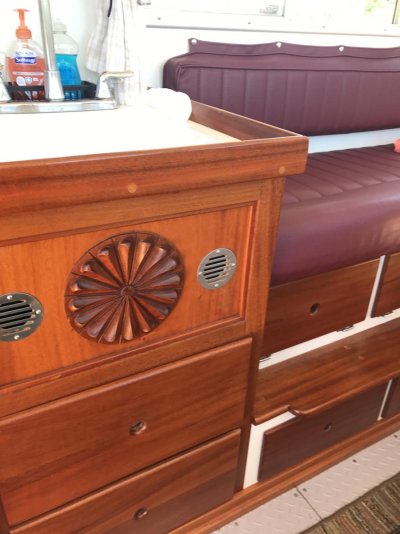With a good prep varnish on teak is good. I’ve put lots of oil on my caprails and use McKloskies spar varnnish (high oil varnish).
Inside my boat is almost all teak. Don’t think it’s ever been varnished. I oil it on occasion (my own mix of oil mostly linseed). The only downside is really old oil gets dark and has a dirty look about it. The smell of turp inside is strong. Mine oiled teak in places should be wooded down but I’ve not done it. It looks fair but I’m not that super fussy.
The plus side of oil is it’s easy to re-do and scraping is not needed. It has the nice warm soft look most want.
A passing thought;
Varnish is a mixture of oils mostly linseed, tung and turpentine that I think comes from trees and is also oil. I don’t think I’m far off saying a case could be made saying teak works best w oil finishes. I planed to just oil a piece of plywood on my foredeck but after about 12 coats of oil I decided to varnish. It’s held up good w the heavy oil base. Only one touch up in about 7 years.
Simplified, Varnish is a mixture of drying oils, resin and solvent. The solvent flashes to let the drying oils, usually tung or linseed to crosslink and polymerize into a lasting finish. The resin crosslinks with the oils and leaves behind a solid. Leave out the resin and you have essentially what is often sold as teak oil. You will still have a curing finish as the carriers flash off, but much less solids being left behind sitting bonded on top of the wood. Basically it soaks in and then cross links. Do that with a non drying oil and it will soak in and look pretty but won’t polymerize.
Personally I prefer the matte oil finish inside, but it does not wear in high traffic, dirty hands areas. Those areas can benefit from a matte varnish with more solids sitting on top and leveling.
Interesting, if you simply repeatedly apply a drying oil, eventually you get a surface that builds and has many of the same characteristics as a traditional varnish. Better to think of teak oils on one end of a spectrum and a varnish on the other than to think as entirely different products. Reality is that many products are somewhere in the middle of the spectrum than one or the other. Lots of the same ingredients, just in different proportions.
Gets even more complicated when you look at poly varnishes where the polymerization is happening with mechanisms other than just drying oils. Someone mentioned epiphanies woodfinish matte, or I use gloss externally. It’s basically a traditional varnish, but also has non drying oil mechanics in addition, so you get benefits like multiple days between coats without sanding. Pretty much indistinguishable from their pure tung oil products visually and flows very predictably as well.
Anyway, it’s good to have some idea of the mechanisms, often to dismiss the wives tales or allegiances to just one mechanic. There are lots of avenues that work together in this oil/varnish/poly cauldron.
I only know enough to be dangerous.

